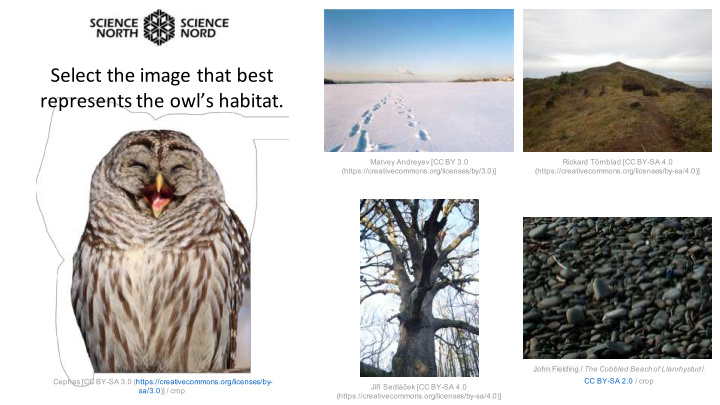



Select the image that best represents the owl’s habitat. Matvey Andreyev [CC BY 3.0 Rickard Törnblad [CC BY-SA 4.0 (https://creativecommons.org/licenses/by/3.0)] (https://creativecommons.org/licenses/by-sa/4.0)] John Fielding / The Cobbled Beach of Llanrhystud / CC BY-SA 2.0 / crop Cephas [CC BY-SA 3.0 (https://creativecommons.org/licenses/by- Jiří Sedláček [CC BY-SA 4.0 sa/3.0)] / crop (https://creativecommons.org/licenses/by-sa/4.0)]
I don’t think this habitat is quite right for this animal. Try Again Xuan Zheng [CC BY-SA 2.0 (https://creativecommons.org/licenses/by-sa/2.0)]
You’re right! Look at how well the owl’s feathers can camouflage in this tree bark. Other physical adaptations: ● Large eyes to see far and at night ● Sharp talons to catch their prey Next Andy Witchger [CC BY 2.0 (https://creativecommons.org/licenses/by/2.0)]
Select the image that best represents the turtle’s habitat. CativatanOverlord [CC BY-SA 4.0 Matvey Andreyev [CC BY 3.0 (https://creecommons.org/licenses/by-sa/4.0)] (https://creativecommons.org/licenses/by/3.0)] USFWS Midwest Region from United States [CC BY 2.0 (https://creativecommons.org/licenses/by/2.0)]/crop Bluescan sv.wiki [CC BY-SA 4.0 W.carter [CC0] (https://creativecommons.org/licenses/by-sa/4.0)]
This turtle’s adaptations may be better suited for a different environment. Try Again Xuan Zheng [CC BY-SA 2.0 (https://creativecommons.org/licenses/by-sa/2.0)]
Great Job! As we can see, turtles can camouflage on logs to hide from predators. Other physical adaptations: ● Hard shell to protect from predators ● Webbed feet makes them strong swimmers Next Wikilouque [CC BY-SA 4.0 (https://creativecommons.org/licenses/by-sa/4.0)]
Select the image that best represents the Snowshoe hare’s habitat. Козинцев [CC BY-SA 4.0 Michael Browning michaelwb [CC0] (https://creativecommons.org/licenses/by-sa/4.0)] D. Gordon E. Robertson [CC BY-SA 3.0 Jebulon [CC0] Jebulon [CC0] (https://creativecommons.org/licenses/by-sa/3.0)]/crop
I don’t think this habitat is quite right for this animal. Try Again Xuan Zheng [CC BY-SA 2.0 (https://creativecommons.org/licenses/by-sa/2.0)]
Congratulations! Snowshoe hares are not only adapted to winter conditions but their fur turns brown in the spring to hide from predators when there is no more snow. Karl Friedrich Herhold [CC BY 3.0 (https://creativecommons.org/licenses/by/3.0)] Other physical adaptations: ● Large hind legs that act like snowshoes in the winter ● Large ears to catch sound from any direction Next ALAN SCHMIERER [CC0]
Select the image that best represents the moth’s habitat. Yath at the English language Wikipedia [CC BY-SA 3.0 Rickard Törnblad [CC BY-SA 4.0 (http://creativecommons.org/licenses/by-sa/3.0/)] (https://creativecommons.org/licenses/by-sa/4.0)] Ben Sale from UK [CC BY 2.0 (https://creativecommons.org/licenses/by/2.0)]/crop Chmee2 [CC BY 3.0 Andreas Weith [CC BY-SA 4.0 (https://creativecommons.org/licenses/by/3.0)] (https://creativecommons.org/licenses/by-sa/4.0)]
This moth’s adaptations may be better suited for a different environment. Try Again Xuan Zheng [CC BY-SA 2.0 (https://creativecommons.org/licenses/by-sa/2.0)]
Yes! The moth can easily camouflage in the tree bark. Other physical adaptations: ● Wings that are used to fly ● The wing pattern can be intimidating to predators Next Ben Sale from Stevenage, UK [CC BY 2.0 (https://creativecommons.org/licenses/by/2.0)/crop
Select the image that best represents the snake’s habitat. Luca Galuzzi (Lucag) [CC BY-SA 2.5 CativatanOverlord [CC BY-SA 4.0 (https://creativecommons.org/licenses/by-sa/2.5)] (https://creecommons.org/licenses/by-sa/4.0)] John Fielding / The Cobbled Beach of Llanrhystud / ToBeFree [CC BY-SA 4.0 Marshal Hedin [CC BY-SA 3.0 (https://creativecommons.org/licenses/by-sa/4.0)] CC BY-SA 2.0 / crop (https://creativecommons.org/licenses/by-sa/3.0)]/crop
I don’t think this habitat is quite right for this animal. Try Again Xuan Zheng [CC BY-SA 2.0 (https://creativecommons.org/licenses/by-sa/2.0)]
That’s AWESOME! Look at how well the snake hides in plain sight! Other physical adaptations: ● Red tail-tip to frighten predators ● Very small fangs to subdue their prey Greg Schechter from San Francisco, USA [CC BY 2.0 (https://creativecommons.org/licenses/by/2.0)]
Recommend
More recommend